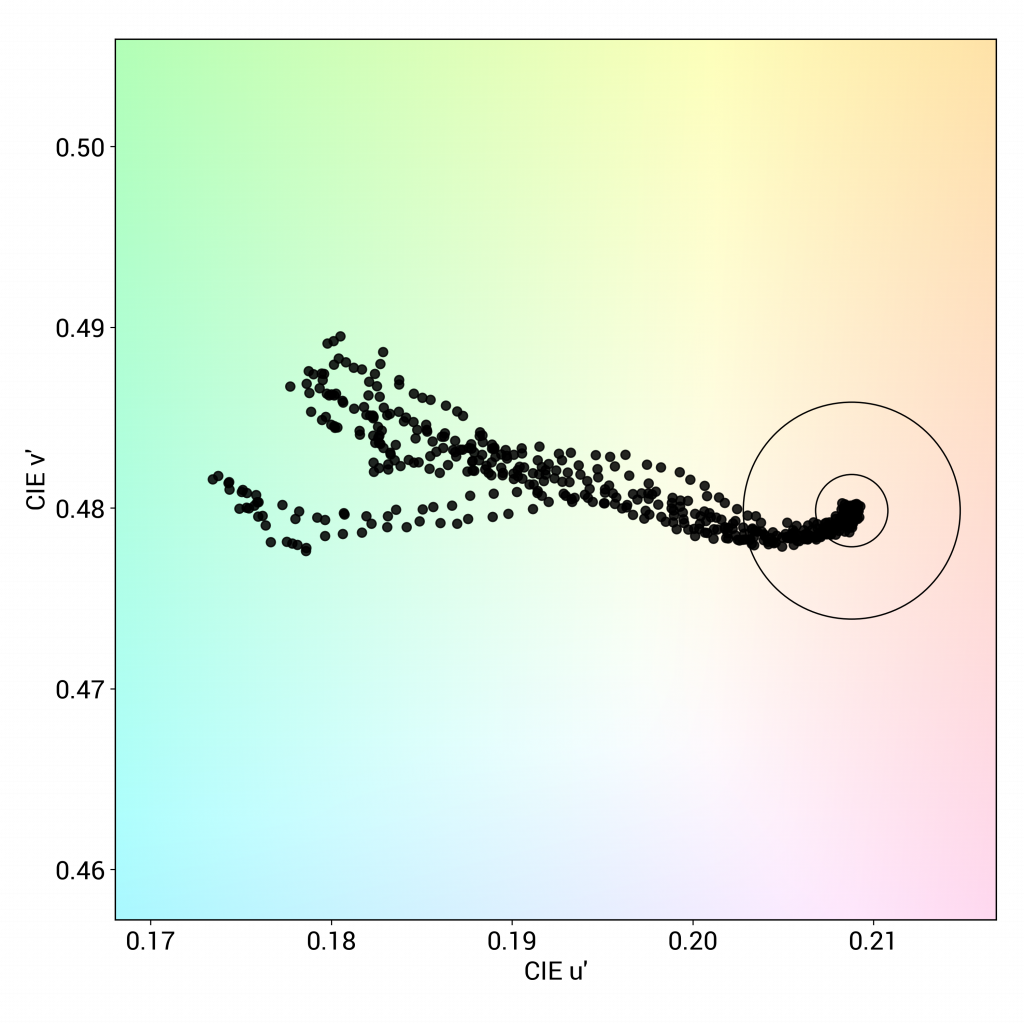Apple iPhone 12 Pro Max Display review: Bigger and still near the top – DXOMARK
Released in November, the Apple iPhone 12 Pro Max is the biggest, heaviest, and most expensive iPhone to date. It’s powered by the same chipset and operating system as the other devices in the 12 line, namely the Apple A14 Bionic. The OLED display is indeed large: 6.7 inches — that’s 109.8 square centimeters of screen. Like other recent iterations of the iPhone, it still has a 60 Hz refresh rate, while many new flagship devices have moved to 90 Hz or 120 Hz.
Key display specifications:
- 6.7 inches OLED, 109.8 cm2 (~87.4% screen-to-body ratio)
- Dimensions: 160.8 x 78.1 x 7.4 mm (6.33 x 3.07 x 0.29 inches)
- Resolution: 1284 x 2778 pixels, (~458 ppi density)
- Aspect ratio: 19.5:9
- Refresh rate: 60 Hz
About DXOMARK Display tests: For scoring and analysis in our smartphone and other display reviews, DXOMARK engineers perform a variety of objective and perceptual tests under controlled lab and real-life conditions. This article highlights the most important results of our testing. Note that we evaluate display attributes using only the device’s built-in display hardware and its still image (gallery) and video apps at their default settings. (For in-depth information about how we evaluate smartphone and other displays, check out our articles, “How DXOMARK tests display quality” and “A closer look at DXOMARK Display testing.”
Mục Lục
Test summary
Scoring
Sub-scores and attributes included in the calculations of the global score.

Apple iPhone 12 Pro Max
127
display
Readability
143
160
Best: Apple iPhone 14 Pro Max (160)
Color
103
163
Best: Huawei Mate 50 Pro (163)
Video
130
162
Best: Samsung Galaxy S23 (Snapdragon) (162)
Motion
134
155
Best: Huawei P40 Pro (155)
Touch
93
165
Best: OnePlus 9 (165)
Artifacts
148
149
Best: LG Wing (149)
Please be aware that beyond this point, we have not modified the initial test results. While data and products remain fully comparable, you might encounter mentions and references to the previous scores.
An overall score of 88 places the Apple iPhone 12 Pro Max in a tie for second place with the OnePlus 8 Pro in our display rankings, and one point ahead of its smaller sibling, the iPhone 12 Pro. The Samsung Galaxy Note20 Ultra 5G (Exynos) holds the top score of 89.
The Apple iPhone 12 Pro Max turns in a strong overall performance, accurately rendering content for readability in most tested conditions and adapting color and brightness very smoothly as conditions change. It turned in a particularly strong showing in video, where it displays excellent brightness and contrast on HDR10 content (but oddly, it was too dark when displaying SDR content). The iPhone 12 Pro Max adeptly handles aliasing, a problem for many other high-end devices, producing smooth curved lines in the gaming use case.
As for the drawbacks, like the other iPhones we’ve tested for display (namely the 12 Pro and the 11 Pro Max), the color cast of the iPhone 12 Pro Max is strongly yellow — something that can be seen in all tested conditions and in video as well as still imagery — and this impacted the score. Our engineers also found the brightness levels a bit dim, especially in low-light situations, and the blue light filter adds a strong orange cast and a dimness that impacts readability.
Let’s take a look at the details.
Analyses and comparisons
The DXOMARK Display overall score of 88 for the Apple iPhone 12 Pro Max is derived from its scores across six categories: readability, color, video, motion, touch, and artifacts. In this section, we’ll take a closer look at these display quality sub-scores and explain what they mean for the user, and we will compare the Apple iPhone 12 Pro Max’s performance in several areas against the Apple iPhone 11 Pro Max, and against two of its key flagship competitors, the OnePlus 8 Pro and the Samsung Galaxy Note20 Ultra 5G (Exynos).
Readability
Apple iPhone 12 Pro Max
72
76
Apple iPhone 13 Pro Max
Best: Apple iPhone 13 Pro Max (76)
DXOMARK uses the device’s gallery app to show static (still image) content when measuring the device’s display for brightness, contrast, gamma, and blue light impact, etc.
In practical terms, the most important aspect of a display is how easily you can read the content in various ambient lighting conditions. The Apple iPhone 12 Pro Max turned in a good overall performance in this attribute, landing just one point below the Samsung Galaxy Note20 Ultra. The device could be brighter in all tested conditions, like its brand siblings the iPhone 11 Pro Max and iPhone 12 Pro, which also tested too dark. The iPhone 12 Pro Max, however, adjusts brightness levels smoothly to changing light conditions, with some slightly noticeable steps. The reaction time is fast when lighting becomes brighter, but a bit slow in fading light.
Brightness vs Contrast comparison (0 Lux)
Brightness vs Contrast comparison (30 000 Lux)
Indoors, the Apple iPhone 12 Pro Max is identifiably less bright than the comparison devices here, including the iPhone 11 Pro Max right next to it.

Indoor lighting, from left to right: Apple iPhone 12 Pro Max, Apple iPhone 11 Pro Max, OnePlus 8 Pro, Samsung Galaxy Note20 Ultra 5G (Exynos
).
Photo credit: DXOMARK; for illustration only
Here you can see that all four devices lose some readability in bright outdoor conditions in the shade; the Apple iPhone 12 Pro Max looks less bright than the other phones, but details are still distinguishable.

Outdoors in the shade, from left to right: Apple iPhone 12 Pro Max, Apple iPhone 11 Pro Max, OnePlus 8 Pro, Samsung Galaxy Note20 Ultra 5G (Exynos).
Photo credit: DXOMARK; for illustration only
The Apple iPhone 12 Pro Max manages direct sunlight fairly well. In this example, the OnePlus Pro 8 is more readable than all the other devices.

In direct sunlight, from left to right: Apple iPhone 12 Pro Max, Apple iPhone 11 Pro Max, OnePlus 8 Pro, Samsung Galaxy Note20 Ultra 5G (Exynos).
Photo credit: DXOMARK; for illustration only
Brightness uniformity is a global feature that our engineers analyze with objective tests and perceptually by displaying a 20 percent gray full screen in the dark to see if variations are detectable. The iPhone 12 Pro Max fares well in this test, although its corners are somewhat darker. (You will be able to see an illustration of this in the color uniformity segment in the Color section further on in this review.)
The Apple iPhone 12 Pro Max loses some brightness when held at an angle, as you can see in the chart of objective test results below:
Brightness vs Viewing Angle comparison
The perceptual tests underline the situation, showing just how much variability there is as the iPhone 12 Pro Max tilts away from axis. Here is a photo illustration of the same array of smartphone images shot on axis in indoor lighting conditions:

Indoor brightness on axis, from left to right: Apple iPhone 12 Pro Max, Apple iPhone 11 Pro Max, OnePlus 8 Pro, Samsung Galaxy Note20 Ultra 5G (Exynos).
Photo credit: DXOMARK; for illustration only
Our perceptual tests for brightness vs angle, undertaken by engineers directly observing the tested devices, confirm the objective test results. All the devices in the comparison lose some luminance when held at a 45° angle, but the Apple smartphones lose more brightness than the OnePlus 8 Pro.

Indoor brightness at 45°, from left to right: Apple iPhone 12 Pro Max, Apple iPhone 11 Pro Max, OnePlus 8 Pro, Samsung Galaxy Note20 Ultra 5G (Exynos).
Photo credit: DXOMARK; for illustration only
At night, the iPhone 12 Max Pro is not bright enough. In the photo illustration below, you can see how it compares with the other devices. Both iPhones are clearly darker than the competition at night.

Brightness in nighttime viewing conditions, from left to right: Apple iPhone 12 Pro Max, Apple iPhone 11 Pro Max, OnePlus 8 Pro, Samsung Galaxy Note20 Ultra 5G (Exynos).
Photo credit: DXOMARK; for illustration only
When the blue light filter is turned on, the iPhone 12 Pro Max gets even dimmer, as does its brand sibling next to it, the Apple iPhone 12 Pro. This has a distinct impact on readability.

Brightness with BLF on, from left to right: Apple iPhone 12 Pro Max, Apple iPhone 11 Pro Max, OnePlus 8 Pro, Samsung Galaxy Note20 Ultra 5G (Exynos).
Photo credit: DXOMARK; for illustration only
Color
Apple iPhone 12 Pro Max
75
92
Sony Xperia 5 IV
Best: Sony Xperia 5 IV (92)
DXOMARK uses the device’s gallery app to show static (still image) content when measuring the device’s display for white point, gamut, uniformity, color fidelity, and blue light filter impact, etc.
Color on the iPhone 12 Pro Max is a mixed bag: its overall score compares well with some of the other devices we’ve tested but remains well behind the OnePlus 8 Pro, which has the top score of 88. A strong yellow/orange cast appears in all lighting conditions and dragged down its overall score. One bright point is that the 12 Pro Max did well adapting its white point to the ambient lighting, unlike many devices.
In the photo illustration below comparing color cast in indoor lighting, you can see the yellowish cast of the two Apple devices on the left, slightly more pronounced on the 12 Pro Max, and the more bluish cast of the OnePlus Pro 8 and the Galaxy Note20 Ultra (Exynos). Our engineers noted that the Apple iPhone 12 Pro Max had good color saturation.

Indoor color, from left to right: Apple iPhone 12 Pro Max, Apple iPhone 11 Pro Max, OnePlus 8 Pro, Samsung Galaxy Note20 Ultra 5G (Exynos).
Photo credit: DXOMARK; for illustration only
Viewed outdoors, the saturation of the 12 Pro Max adapts well, but the yellow/orange cast is still visible.

Outdoor color, from left to right: Apple iPhone 12 Pro Max, Apple iPhone 11 Pro Max, OnePlus 8 Pro, Samsung Galaxy Note20 Ultra 5G (Exynos).
Photo credit: DXOMARK; for illustration only
In terms of color fidelity, the charts below show the color tendencies and the direction of the color shift of the Apple iPhone 12 Pro Max under 1000 lux lighting in both the sRGB (standard) color space (left) and the broader DCI-P3 color space (right). The center of each circle is the target color; anything outside the circle represents a noticeable color difference. The further the tip of the arrow is outside of the circle, the more a user will notice the difference between the color on the display and color of the real object or chart next to it. The 12 Pro Max in both cases produces good results.

Apple iPhone 12 Pro Max, color fidelity at 1000 lux in the sRGB color space

Apple iPhone 12 Pro Max, color fidelity at 1000 lux in the DCI-P3 color space
The Apple iPhone 12 Pro Max screen is quite uniform overall except in the corners. In this photo illustration, you can see the slight variations in color and brightness, as mentioned earlier in the readability section. Of the devices pictured here, the OnePlus 8 Pro has the biggest divergence from uniformity, with some color variation toward the bottom and edges of the screen. The Samsung Galaxy Note20 Ultra 5G (Exynos) also shows some non-homogenous variations, but it’s harder to see in this photo because it’s brighter than the other devices. The iPhone 11 Pro Max, second from left, is even more uniform than its brand sibling.

Color uniformity, from left to right: Apple iPhone 12 Pro Max, Apple iPhone 11 Pro Max, OnePlus 8 Pro, Samsung Galaxy Note20 Ultra 5G (Exynos).
Photo credit: DXOMARK; for illustration only
White (color) vs angle
Users sometimes hold their smartphones at an angle, which can affect the display of color rendering. The left-hand chart below shows the Apple iPhone 12 Pro Max’s color tendencies when held at an angle; in the right-hand chart (essentially a closeup of the left chart), each dot represents a measurement taken at a discrete angle from the device; dots inside the inner circle exhibit no color shift in angle; those between the inner and outer circle have shifts that are just noticeable by trained experts; but those falling outside the outer circle are noticeable. The 12 Pro Max has a distinct shift into a greenish cast, more intense the greater the tilt away from axis.

White point on angle, Apple iPhone 12 Pro Max

White point on angle scatter, Apple iPhone 12 Pro Max
The photos below illustrating our perceptual tests (which are made by direct observation, not by looking at photos) echo the objective measurements. The first set is shot on axis (perpendicular to the viewer); the second set is shot at a 45° angle. On axis, the Apple iPhone 12 Pro Max and the iPhone 11 Pro Max both have more of a yellow cast than the other two devices in the comparison:

Indoor color on axis, from left to right: Apple iPhone 12 Pro Max, Apple iPhone 11 Pro Max, OnePlus 8 Pro, Samsung Galaxy Note20 Ultra 5G (Exynos).
Photo credit: DXOMARK; for illustration only
On angle, the shift toward a greenish cast can be seen in the petals of the sunflowers in the photo displayed on the iPhone 12 Pro Max. The OnePlus 8 Pro does a better job of retaining the original rendering:

Indoor color at 45°, from left to right: Apple iPhone 12 Pro Max, Apple iPhone 11 Pro Max, OnePlus 8 Pro, Samsung Galaxy Note20 Ultra 5G (Exynos).
Photo credit: DXOMARK; for illustration only
With the blue light filter on, the Apple iPhone 12 Pro Max takes on a distinct orange-yellow cast; it’s also evident in the iPhone 11 Pro Max. Though the BLF is effective at removing sleep-disturbing blue light, the orange cast is a bit distracting. The Samsung Galaxy Note20 Ultra 5G (Exynos) hardly looks different when the BLF is on, as the filter doesn’t remove much blue light.

Color shift with BLF on, from left to right: Apple iPhone 12 Pro Max, Apple iPhone 11 Pro Max, OnePlus 8 Pro, Samsung Galaxy Note20 Ultra 5G (Exynos).
Photo credit: DXOMARK; for illustration only
Video
Apple iPhone 12 Pro Max
75
91
Samsung Galaxy S22 Ultra (Snapdragon)
Best: Samsung Galaxy S22 Ultra (Snapdragon) (91)
DXOMARK uses the device’s video (or browser) app to show dynamic content when measuring the device’s display for brightness, contrast, gamma, and color.
The Apple iPhone 12 Pro Max scored fairly well for watching videos, placing it among the better devices for his attribute, though below the 83 scored by the Samsung Galaxy S20 Ultra 5G (Exynos). It produced an appropriate and pleasing brightness when displaying HDR10 content. (Note that the perceptual score is based on direct observation of the tested device, not the photo illustration here.)

HDR brightness from left to right: Apple iPhone 12 Pro Max, Apple iPhone 11 Pro Max, OnePlus 8 Pro, Samsung Galaxy Note20 Ultra 5G (Exynos).
Photo credit: DXOMARK; for illustration only
On SDR content, however, the Apple iPhone 12 Pro Max does not perform as well; the content is much darker than the HDR10 content, as illustrated with this comparison of video images from the Apple device on the left and the Samsung Galaxy Note20 Ultra 5G (Exynos) on the right.

Brightness when displaying SDR content, from left: Apple iPhone 12 Pro Max, Samsung Galaxy Note20 Ultra 5G (Exynos). .
Photo credit: DXOMARK; for illustration only
The Apple iPhone 12 Pro Max showed low contrast in mid-tones and especially in reds, but dark details are well-rendered in HDR10 content. The OnePlus 8 Pro and Samsung Galaxy Note20 Ultra 5G (Exynos) did not render dark detail very well, as seen in this photo illustration from a video of glass blowing.

Video contrast: Apple iPhone 12 Pro Max, Apple iPhone 11 Pro Max, OnePlus 8 Pro, Samsung Galaxy Note20 Ultra 5G (Exynos).
Photo credit: DXOMARK; for illustration only
As in the color attribute, the Apple iPhone 12 Pro Max displays a strong yellow cast when playing video content, which is also visible in the 11 Pro Max image next to it in the illustration below. The yellow cast is also visible in skin tones, which you can see in the first photo in the video section above.

Video color, from left to right: Apple iPhone 12 Pro Max, Apple iPhone 11 Pro Max, OnePlus 8 Pro, Samsung Galaxy Note20 Ultra 5G (Exynos.)
Photo credit: DXOMARK; for illustration only
Motion
Apple iPhone 12 Pro Max
81
87
Huawei P40 Pro
Best: Huawei P40 Pro (87)
The Apple iPhone 12 Pro Max scored well in the motion attribute, producing very few stutters at 30 or 60 fps. Our engineers noted that frame drops were also rare when playing video games. In terms of motion blur, the device doesn’t show any frame duplications and appears sharp. When it comes to video playback reactivity, there was a fraction of a second of hesitation before playing the video, and the device displays some artifacts in that moment — blocking and pixelation.
Touch
Apple iPhone 12 Pro Max
61
85
OnePlus 9
Best: OnePlus 9 (85)
For this attribute, the Apple iPhone 12 Pro Max tied the score of its brand sibling, the iPhone 12 Pro, and improved by a few points on the 11 Pro Max. However, it is still well behind the OnePlus 8 Pro, which is the leader here at 83 points. The iPhone 12 Pro Max is very accurate when zooming in the gallery app, but there is a lack of smoothness noticeable in all conditions, whether in the gallery app, when browsing the web, and when gaming.

The Apple iPhone 12 Pro Max scored well for accuracy in zooming in the gallery app, accurately following the movement of the user’s fingers.
Photo credit: DXOMARK; for illustration only
Artifacts
Apple iPhone 12 Pro Max
84
86
Apple iPhone 13 Pro Max
Best: Apple iPhone 13 Pro Max (86)
The Apple iPhone 12 Pro Max achieved a very good score in artifacts, tying for first place in this attribute with the OnePlus 8 Pro. That said, the quite prominent notch at the top was a drag on its score because of the way it intrudes on the screen, a detriment to gaming and video-viewing. It is, however, an improvement on the iPhone 12 Pro, as the Apple iPhone 12 Pro Max has a screen-to-body ration of 87.4 percent vs. 86 percent for the iPhone 12 Pro.
Our engineers detected no ghost touches or inappropriate responsiveness to inadvertent touches of the finger or other parts of the hand, a plus; and there was no judder visible at 24, 30, or 60 fps.
Flicker can be noticeable in low-light conditions.
Flicker comparison
This graph represents the frequencies of lighting variation; the highest peak gives the main flicker frequency.
The Apple iPhone 12 Pro Max produced well-defined lines in the gaming use case. Aliasing — a jarring stair-step effect — often occurs on smooth and curved edges. This illustration for comparison purposes (remember, the engineers use direct observation of the devices in perceptual tests) shows just how smooth those lines can be. If you look along the car roofline in the images from the OnePlus 8 Pro and the Note20 Ultra 5G (center and right), you can see some of that stair-stepping.

Apple iPhone 12 Pro Max
Photo credit: DXOMARK; for illustration only

OnePlus 8 Pro
Photo credit: DXOMARK; for illustration only

Samsung Galaxy Note20 Ultra 5G (Exynos)
Photo credit: DXOMARK; for illustration only
Conclusion
Because of its size and price, the Apple iPhone 12 Pro Max may not be for everyone, but it continues in the brand’s tradition of producing quality devices that maintain a loyal following. The iPhone 12 Pro Max’s display does nothing to detract from that tradition. It excels at video playback, with great brightness for HDR10 content. And in general, the device renders colors accurately in most tested conditions, though with the caveat that there is a strong yellow cast to both video and still imagery— a consistent characteristic of the Apple devices our display team has tested to this point. The device could also be brighter, especially in low-light and at night, and flicker is also an issue in low-light conditions.
Pros
- HDR10 video brightness and contrast are well managed across the board.
- Well-managed gamma ensures that images are rendered well even in sunlight.
-
Transitions are smooth between different levels and sources of light.
- Aliasing is particularly well managed in gaming.
Cons
- A yellow cast is visible in all tested conditions in both video and still imagery.
- Brightness is often low, particularly at night.
- The blue light filter diminishes readability and has a strong orange cast.
- Flicker is noticeable in low-light conditions.























![Toni Kroos là ai? [ sự thật về tiểu sử đầy đủ Toni Kroos ]](https://evbn.org/wp-content/uploads/New-Project-6635-1671934592.jpg)


